In this period of confinement where physical interactions are limited, we are obliged to animate our workshops remotely using a multitude of tools. Even if the latter greatly reduce our pain, I nevertheless believe that physical distance greatly affects the effectiveness of group facilitation, whether for the participants or for the facilitator.
In this article, I invite you to relive with me an experience of a remotely facilitated workshop with my difficulties, my learnings and my reflections.
Happy reading ! 🙂
Context and challenges

The workshop in question corresponds to the rest of the article: " a role clarification workshop“.
The main idea is to confront 2 visions of a role called “Tribe Lead” (corresponding to an IT Product Management).
This second workshop has several challenges:
- In terms of Objectives
- Capitalize on the good momentum generated by the previous workshop,
- Allow Tribe Leads to express themselves on their vision of the role entrusted to them,
- Confront the different visions to agree on a common vision at a given time.
- In terms of frame
- Propose a mechanism in the same spirit as before: that is to say participatory, collective and contextual,
- and all this remotely.
However, it is necessary to specify some specific constraints:
- I have no knowledge of the level of comfort of the participants with the technology
- Habits of the house are to have remote meetings in audio only
- In view of the technical difficulties linked to the slowness of the internal network, a blocking of video streams on internal stations has been put in place.
- The choice of communication / collaboration tools is restricted to those validated by group security
Design and Preparation

By taking the previous elements of context, here we go for the design of the workshop.
The framework will be as follows:
- a planned timing of1h30,
- an estimated number of people less than 10.
For the choice of timing, I went back to something similar to the previous workshop even if the content will probably be richer in exchanges and interactions. It is mainly for the sake of clarity that I have preferred to propose an equivalent duration.
1. Diary
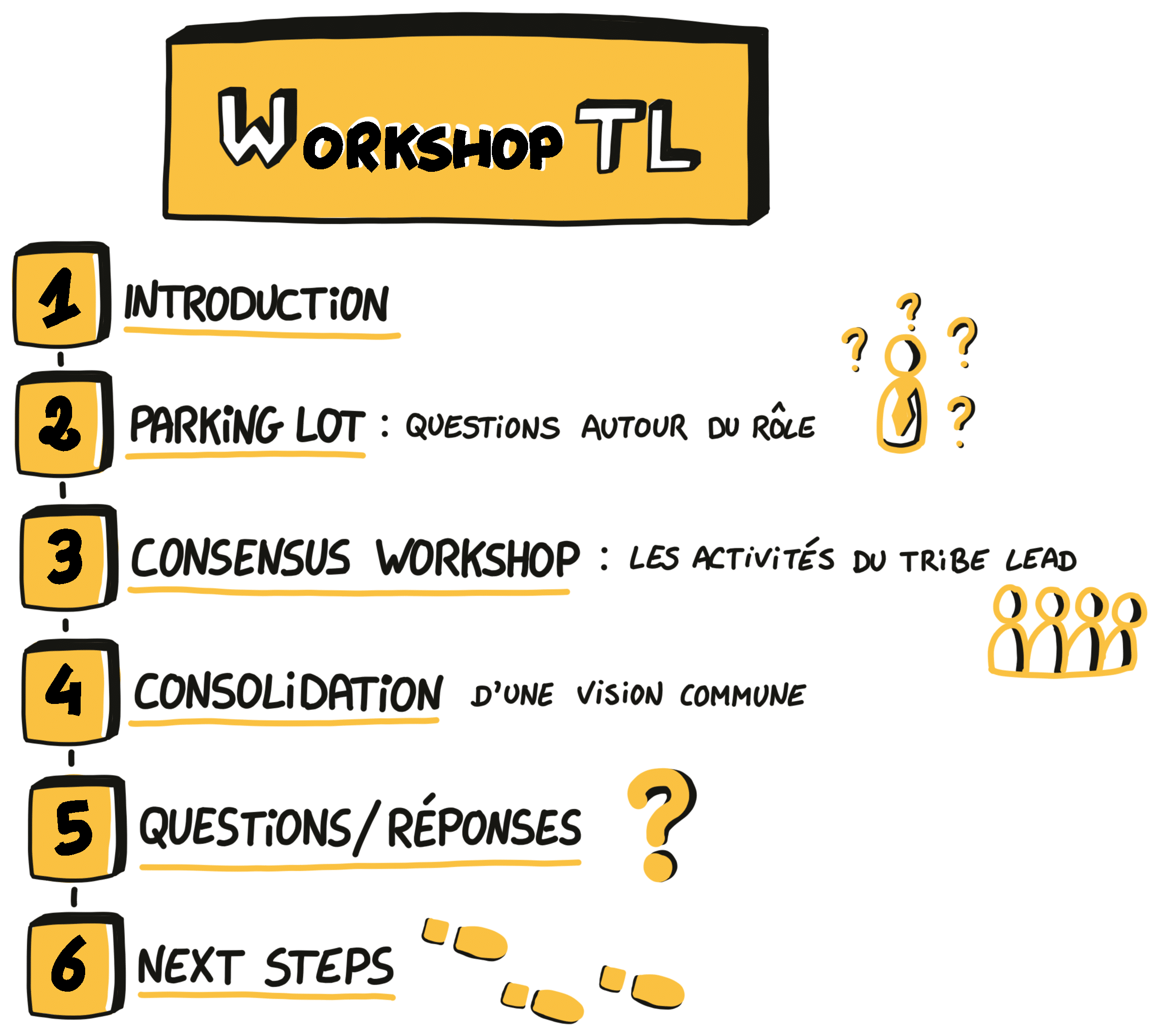
2.Parking Lot
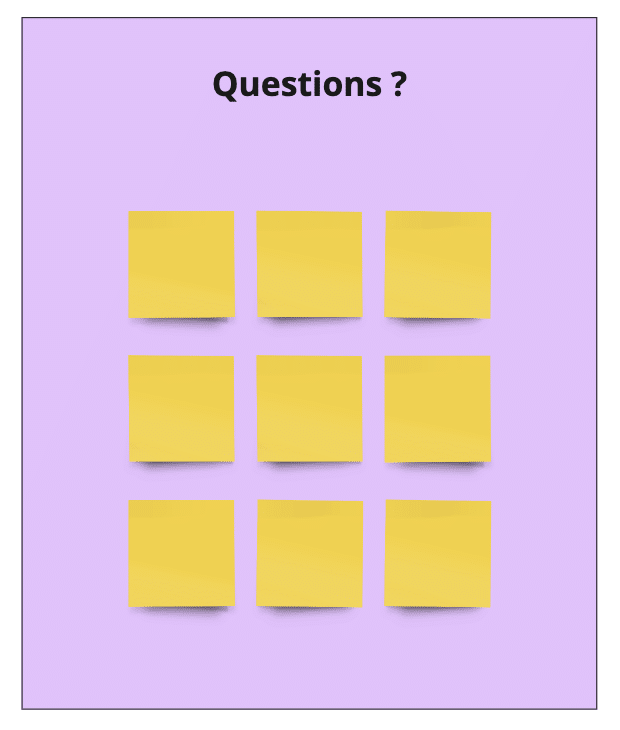
Given the history of this series of workshops, it seemed important to me that participants have the opportunity to freely express their questions, whatever their nature. Indeed, in an ambient vagueness that a transformation can generate, everyone has their own way of managing stress, anxiety and the unknown. For this, quite simply, we will have a Parking Lot sequence so that everyone can submit your main questions.
We will not answer it immediately to get down to the heart of the animation. However, starting with this step will not only allow us to take the pulse, but also the Management in attendance to be able to reflect on the answers.
3. Consensus Workshop
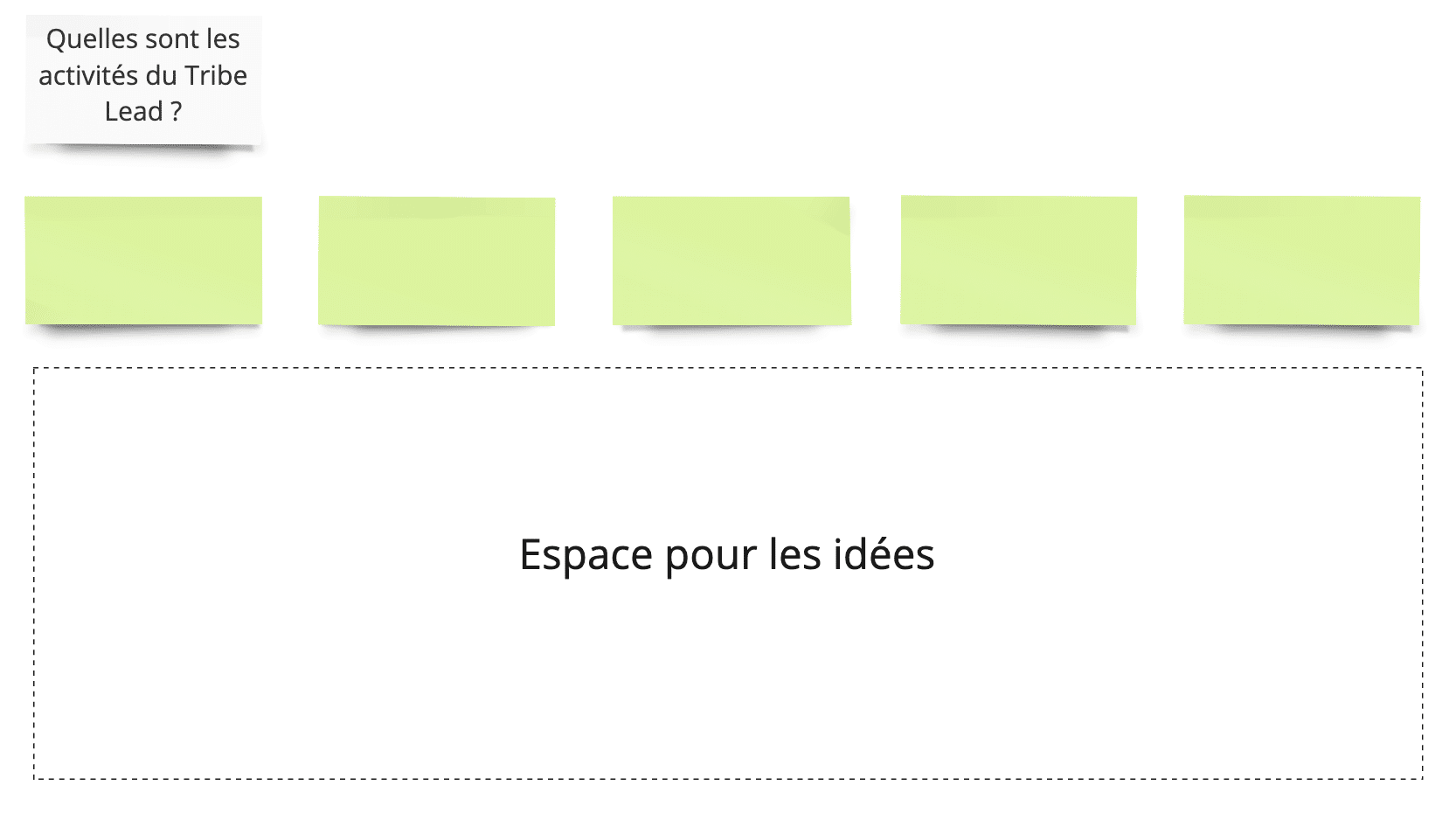
In the same way as for the previous workshop, I would ask the participants to answer the following question: “What are the activities of the Tribe Lead? ".
However, there will be a difference in the proposed mechanics due to technical constraints. Indeed, I intended to use Zoom and its breakout rooms to provide the same experience of pre-screening and discussions prior to Tribe Leads, but its current bad press in terms of security has dissuaded me: my client is particularly picky about these aspects.
So I decided on a degraded mode:
- Individual reflection time of 3 to 4 minutes,
- Passage each in turn to express their ideas while removing duplicates: the bet being that the last passages are much faster thanks to pre-filtering,
- Naming categories.
4. Consolidated vision
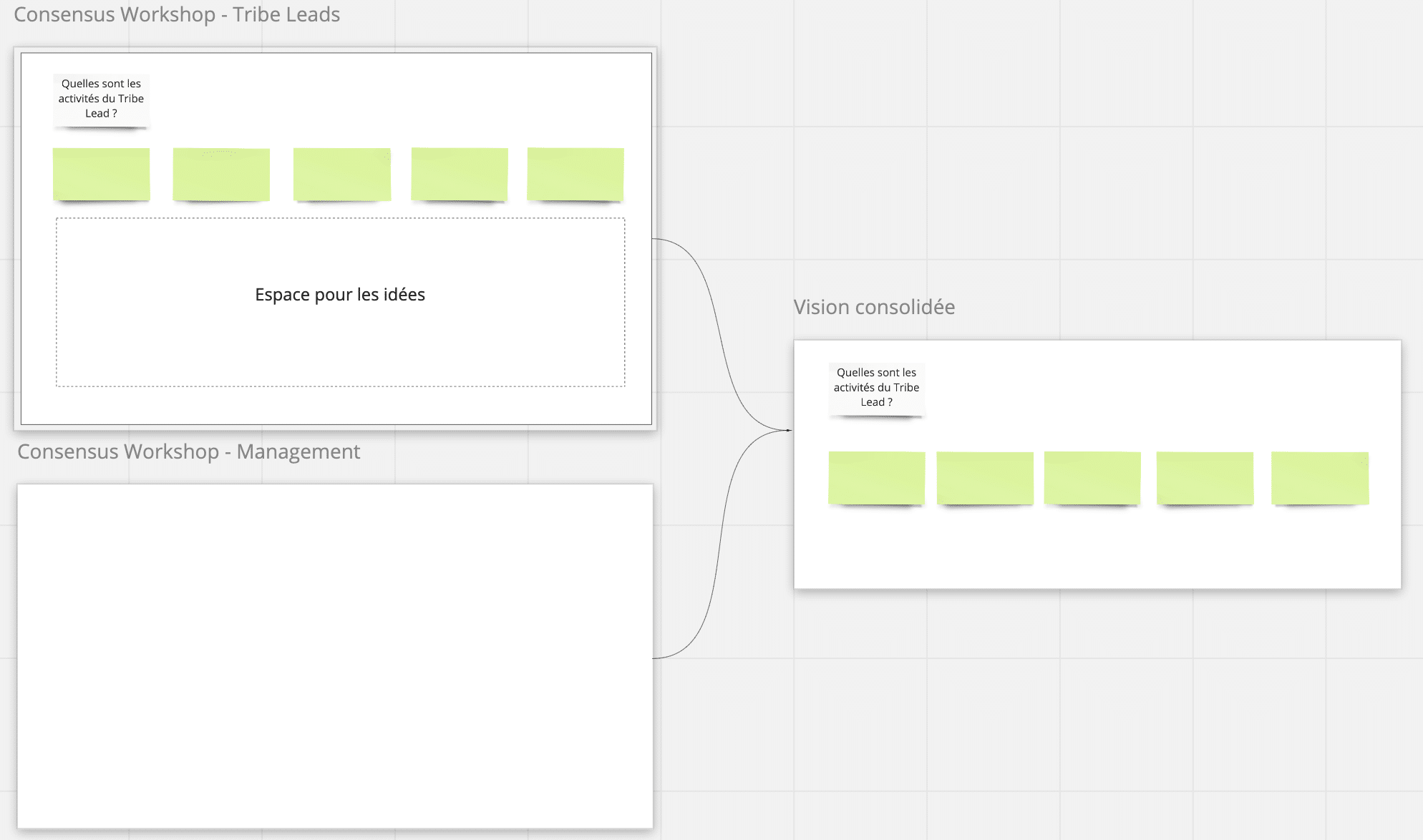
After having obtained a vision from the side of the Tribe Leads, we will compare it with the management vision obtained during the previous workshop. So to do this, I will ask the management in attendance to take the lead to debrief on the elements that are similar and those that are different. This will then be a good opportunity to create exchanges, to raise questions and to align ourselves on certain subjects.
As for the previous workshop, the Management version will be hidden and then revealed at the last moment to allow everyone to be able to compare the 2 visions.
Our objective here will be to build a consolidated vision on the basis of categories (green Post-its) rather than on activities. Indeed, in view of the heterogeneity of the people present by their respective perimeter, it seemed to me more judicious to do it this way to give more flexibility to the implementation knowing that each team can have a slightly different mode of operation. .
| Note: this is the same idea as focusing on Agile principles rather than practices |
5. Questions / Answers
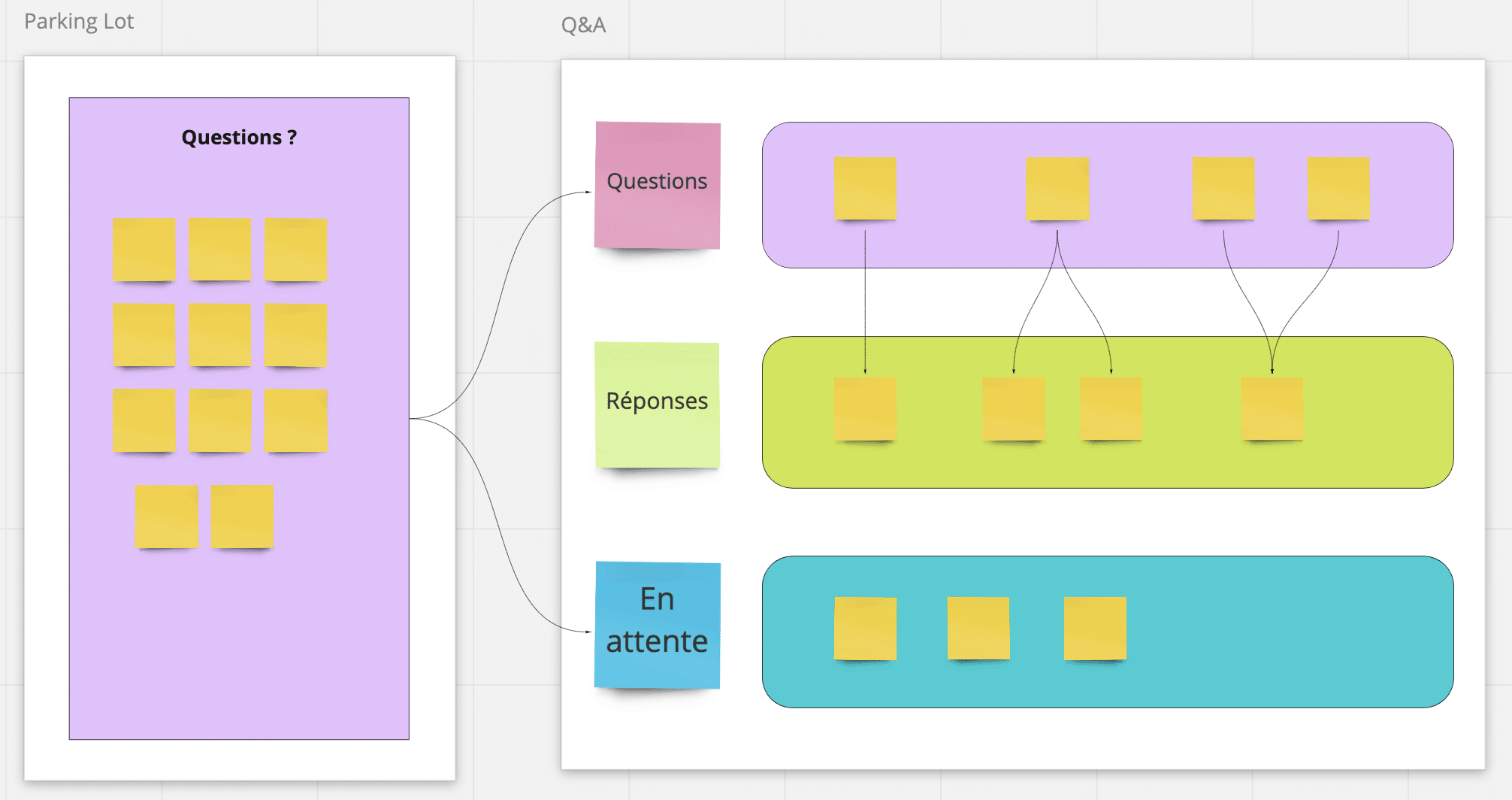
A moment of discussion around the questions should take place. The idea being of course to tackle as many as possible during the workshop. The management involved will then have a visual support to prepare this sequence with a simple logic:
- moving or copying the Post-it to the “Questions” or “Pending” block,
- one or more answers in the answers block,
- and a link to connect questions and answers: this gives us the flexibility to cover the cases of one question / one answer, one question / several answers and several questions / one answer.
For pedagogical reasons, I placed arrows to indicate the direction of the supply of the 2 stocks
6. Next Steps
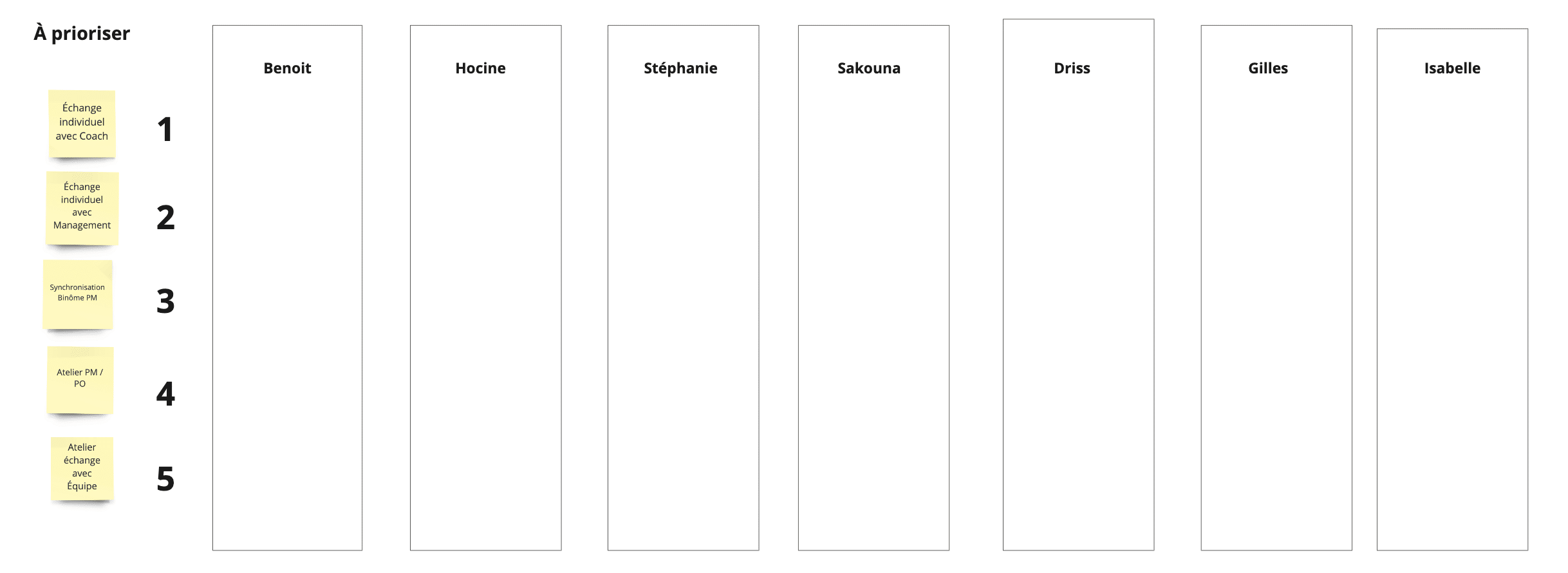
To conclude our workshop, I will suggest that participants prioritize the next support steps according to their current needs. Indeed, rather than simply imposing on them what to do next, I found the reflection exercise interesting in order to also be able to organize our efforts on our side.
We will present each element with the objectives / expected inputs in order to allow them to schedule in an informed way.
| Note: to limit manipulation as much as possible (copy/paste in this case), we have duplicated each item directly in the boxes of each person, but for the sake of readability of the article, the list only appears once . |
Additional preparations

A successful workshop is largely in the preparation. This is even more true from a distance. So, to minimize latency in the animation, I undertook some additional preparation elements that I explain below:
1. Visual Support
To facilitate a workshop of this kind, it was essential to rely on a common visual support in order to allow participants to follow the course of the workshop, to ensure that they are talking about the same thing and hope to understand each other better. In our case, we will use Miro.
Technically speaking, Miro is a large whiteboard on which you can build whatever you want. The main difficulty is then to find the right thing, especially when the content becomes quite substantial. Indeed, we are most of the time obliged to use the zoom and un-zoom functionalities to be able to find our way around. I then used the integrated system of Frames, allowing to refocus on a pre-determined content to allow participants to move from one sequence to another with greater ease.
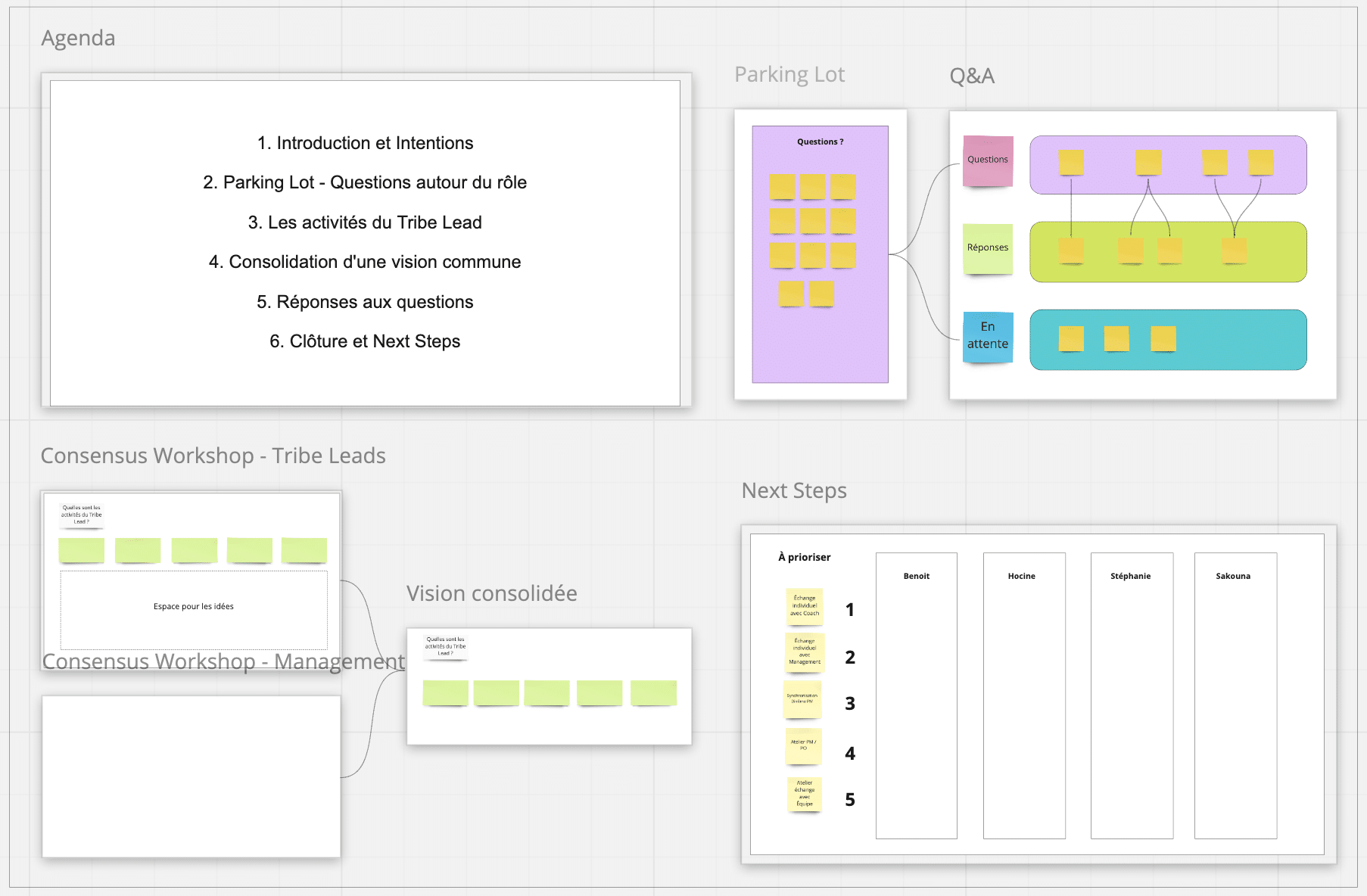
They will be able to navigate between: the agenda, the parking lot, the consensus workshop – Tribe Leads, the consensus workshop – Management, the consolidated vision, the questions / answers and the next steps.
After discussion with my fellow coaches, we also decided to set up specific areas per participant with Post-its already ready to use: indeed, this will allow them to write their ideas directly, thus limiting the latency time. to find a space, create Post-its and tag them.
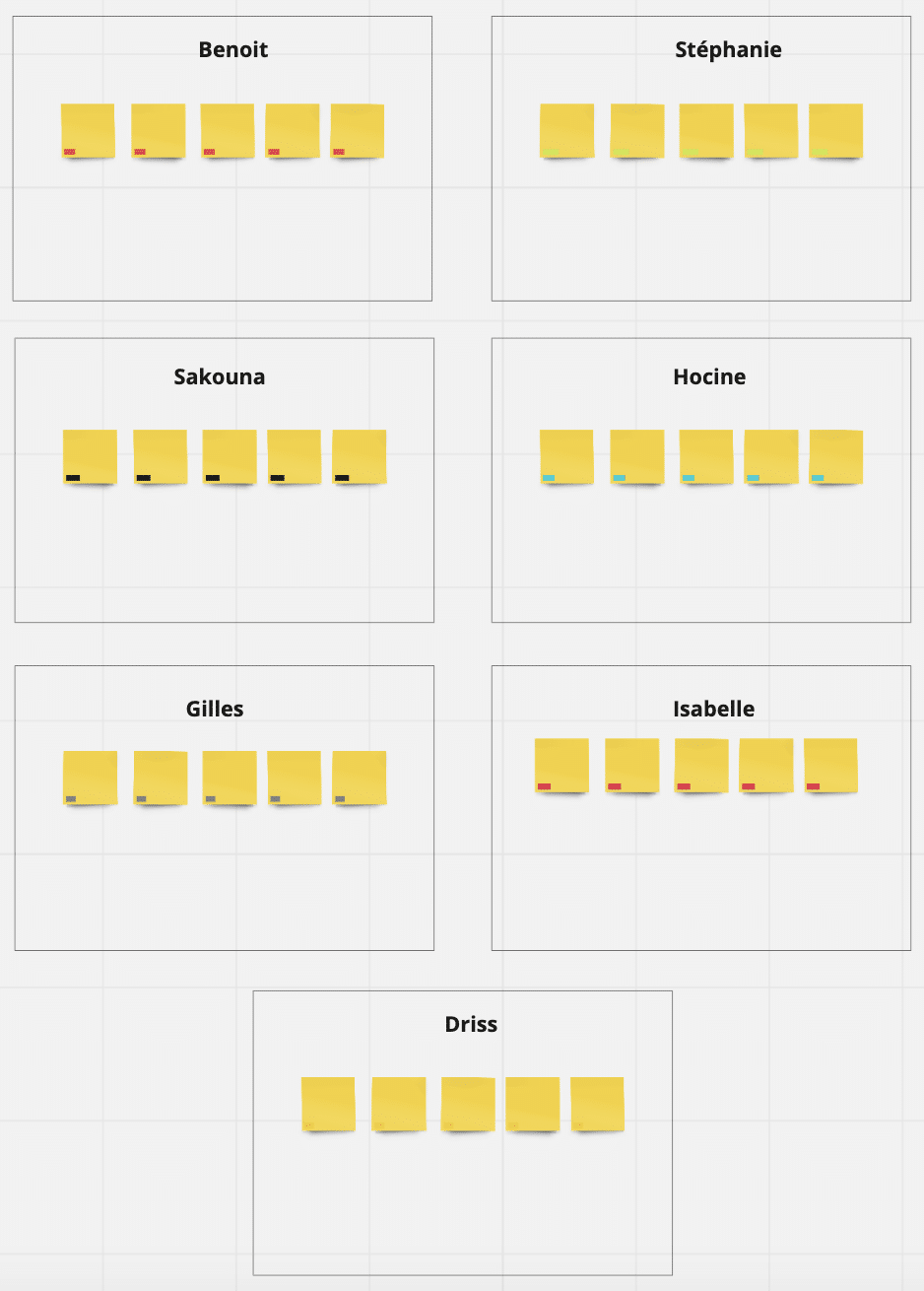
Finally, to avoid handling errors as much as possible, I froze as many frame elements as possible: only the Post-its were mobile.
2. Participant Briefing
One of the major sources of wasted time is the fact that the participants get to grips with the tool at the start of the session.
To limit this risk as much as possible, I sent them a message before the workshop to make sure:
- that they were well able to access the visual support: the internal network being particularly capricious lately,
- that they were able to perform the basic manipulations that will be required of them: move a post-it, to write in a post-it, add a tag, duplicate a post-it.
I also made myself available during a time slot preceding the workshop to help them if necessary.
3. Briefing Co-hosts
To cover my back, I also asked my 2 fellow coaches to help me in terms of logistics and assistance to participants on the tool. Indeed, I think it's already a big success factor in face-to-face, so even more so in the context of remote animation. A significant additional element: it's reassuring 🙂
We took a good hour together so that I could present to them:
- animation frame,
- the various interventions planned,
- the estimated timing,
- the possible risks of deviations,
- and visual support.
This allowed us to be very synchronous during the animation with a clear role for each.
4. Briefing Managers
The stakes of this workshop being to open the exchange between different hierarchical levels, it was important for me to involve the layer of Management in the animation.
So I took a moment with them to tell them the nature of the interventions I needed from them:
-
- Introduction : to clarify the intentions and challenges of the workshop, in other words "why the participants are there". I absolutely did not want the workshop to be experienced as an "imponderable" of the transformation, but rather as a need coming from within.
I'll take over later.
-
- Parking lot : while the participants fill in the Post-its with their questions, the management will be responsible for preparing the answers if they are known. Indeed, we never really know what we will come across so we accept that questions may remain unanswered (at least during the workshop).
The main idea being to speed up the end-of-workshop Q&A sequence.
-
- Consensus Workshop – Tribe Lead : I invite them to stay tuned to what will be said during the sequence. Indeed, it will help them to make the comparison with their own results.
The idea here is that they do not participate but feed on the content to be able to intervene in a relevant way afterwards.
-
- Consolidation Common Vision : I then ask them to participate in this phase by quickly describing what is similar but to take time especially on the differences whether by addition or omission. I also send them the result of their previous workshop to have it visible and to be able to compare more easily.
The objective here is to create the exchange in order to converge towards a consolidated vision.
-
- Questions answers : I will animate the question/answer part in order to give rhythm to the discussions but the exchanges will of course be between the Management and the Tribe Leads.
I hope here that the number of questions has reduced during the workshop!
-
- NextSteps : nothing special here for them apart from special attention to an action concerning them entitled: “individual discussion with Management”. This is an action on which I had insisted because it seemed essential to me that the Management weave a link with each person individually, to have their feelings following the workshop and especially their potential fears, perhaps not expressable in group. The positioning of this action in the backlog of each participant will allow the Management to make appropriate arrangements.
We can therefore see that the role of Managers in animation is essential. This allows them to be fully engaged and stakeholders in the content that will emerge from the workshop.
Animation
After a restless night's sleep, we finally arrived at the fateful hour.
14:00 – Last checks before the workshop
A good hour and a half before, I make some checks on the connection on the visual support. Indeed, having the possibility of seeing the activated members and their associated e-mail address, I could see if the participants had taken the time to create an account if it had not already been done or to access the simply space. Of course, 3 more people were missing.
5 minutes before the start, I learn that a person will finally not participate in our workshop. So all I have to do is make sure that the 2 missing people will be operational.
15:30 – Beginning of the workshop
Unsurprisingly, we start about ten minutes late, by the time everyone arrives and the last person creates their account and logs into Miro. It is finally done rather well and we can thus start.
This workshop being highly anticipated, a dozen people are also connected to it, as observers. I take this opportunity to clarify the rules:
The only people authorized to speak are the people participating in the workshop.
I would ask others to please mute their microphones to limit outside interference as much as possible. THANKS !
15:40 – Intro
We then start with the introduction supported by the Managers. They express in a few minutes their findings, the difficulties encountered on the way and thus the intentions of this workshop. It's perfect, I'm taking control!
Let's go to the Parking Lot.
15:45 – Parking Lot
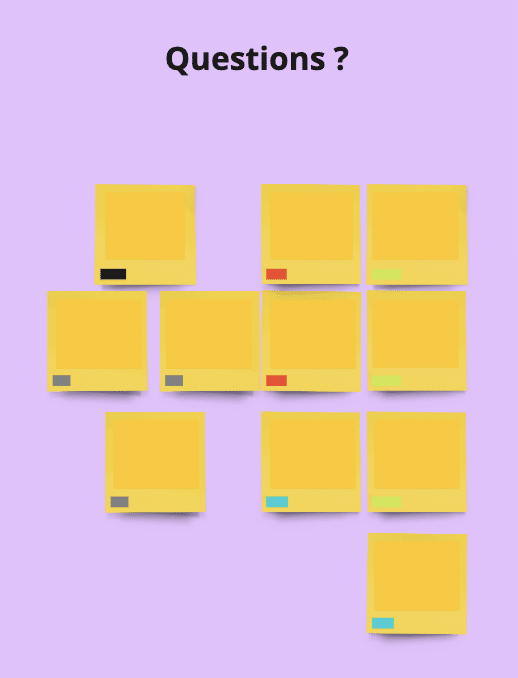
I then direct the participants to the Parking area. After giving the instructions, I wait for the first mouse movements and the first Post-its. However, the participants seem shy and nothing happens for a good thirty seconds. I have to raise again to find out if there is indeed no question or if it is time for reflection.
People are finally getting started and you can see their personality differences in the way they write in their Post-its. Some are hesitant, others are very inspired and even start cracking jokes. For once, the game is worth the candle: the atmosphere is good, the participants are on the move and appropriate the tool.
About ten Post-its later, we move on to the next sequence.
| Facilitator's Note : my attention is not only focused on the movements of the participants but also on the movements of my fellow support coaches. Everyone is present, it's encouraging. I then expect to see the managers' mice move to start dealing with the various issues and to my surprise, not much happens. It's strange. However, I must continue to animate the sequel. |
15:50 – Consensus Workshop
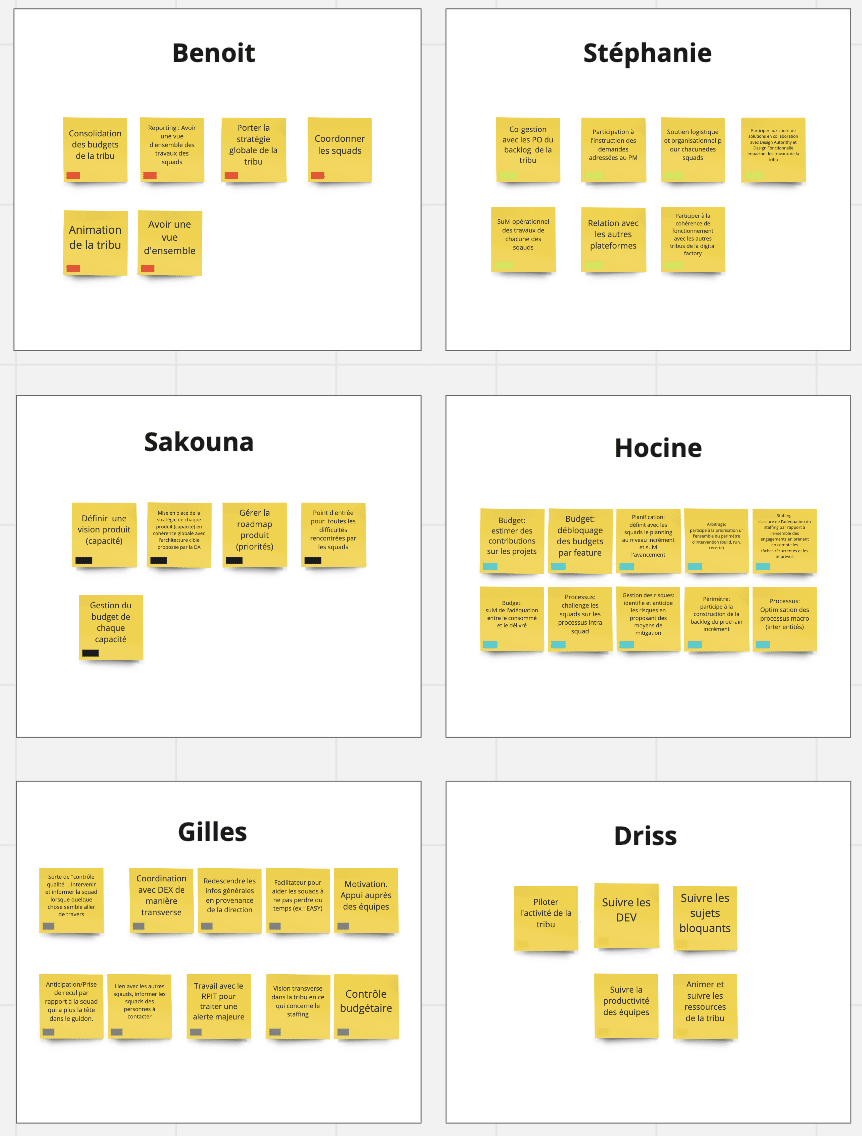
We then head to the Consensus Workshop area. I specify to the participants that this area will be dedicated to the debriefing and that they have a space just next to it assigned to them.
To better orient the participants on the workspace, the coaches begin to draw large arrows to indicate the direction to follow. It seems to work quite well: everyone seems to find their space easily. So we can start the mechanics.
I then give everyone 5 minutes to answer the question. I make it clear to them that there is not an expected number of answers and that the important thing is to answer from their own frame of reference.
I take this opportunity to look at the side of the Questions / Answers area and I start to see some mouse movements from the managers. There are mostly groupings of questions at the moment, this is not serious in itself but I find that their execution speed is not very high. Maybe they have technical problems?
When a few mice stop moving, I ask the participants if we can move on. The answers don't come right away, with some people still writing things down, but it's interesting to see that some seem a lot more inspired when asked if they're done.
| Facilitator's Note : the difficulty of the exercise is that I am here only in supposition, being totally blind on the non-verbal of the people. I also assume that everyone will answer honestly with their own ideas rather than looking to others for the "right" answers. |
I then launch the debriefing phase, rather confident about the timing so far.
16:00 – Debriefing Consensus Workshop
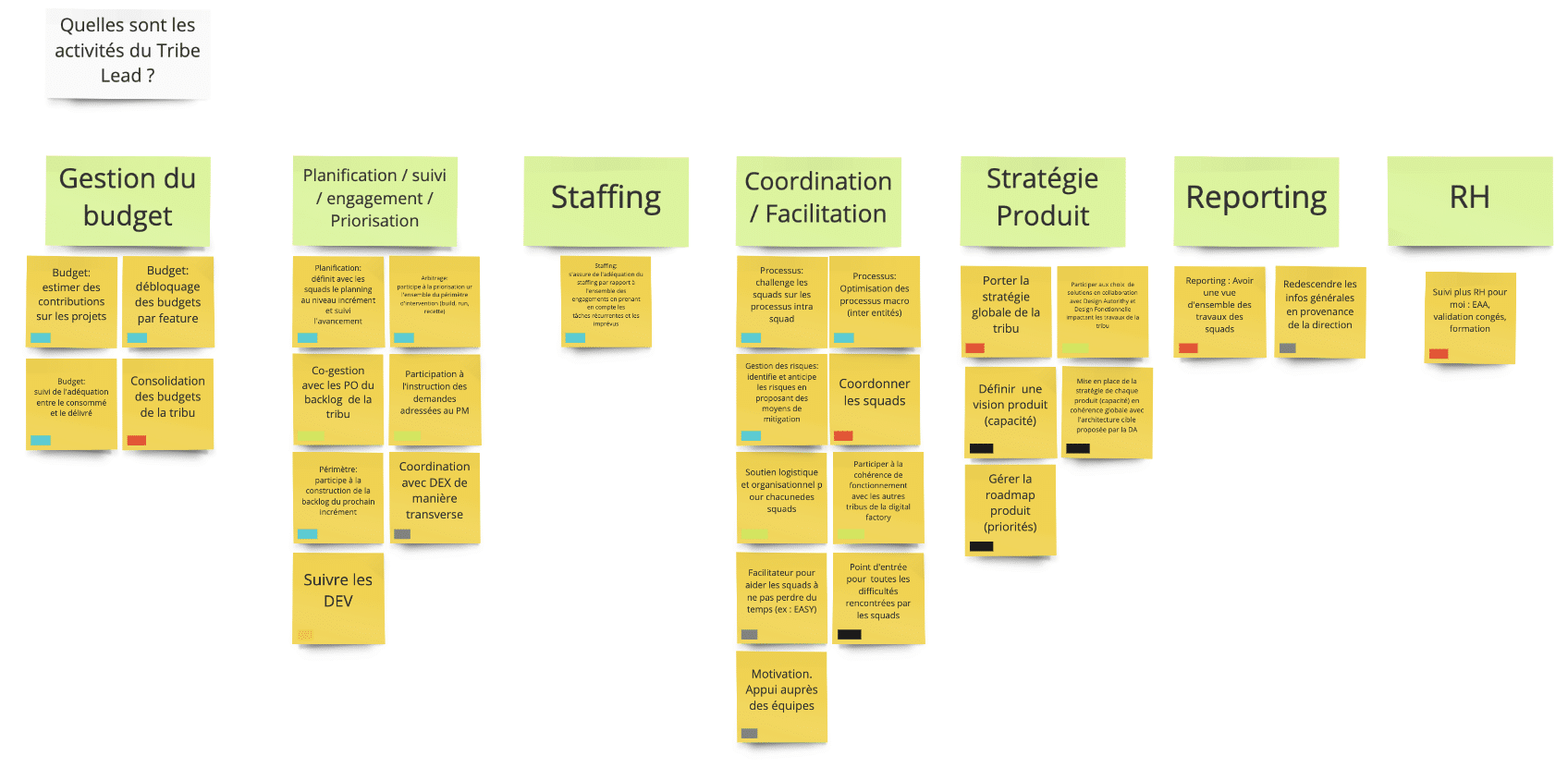
I then invite a person to start to give the impetus. I'm lucky, a particularly constructive participant starts. It is also the one with the most Post-its, a good opportunity to filter the answers of the whole group!
He thus exposes his ideas one after the other in a very structured way, so structured that he has already classified them under categories. It's a bit double or nothing in the sense that it can be a source of influence for others, but let's deal with it. Moreover, being the first to pass, he serves as an example to others. The problem is that, wanting to do well, he tends to go into an unnecessary level of detail, which lengthens his monologue and slows down the pace of the workshop.
| Facilitator's Note : it is moreover much more difficult for me to cut it in its explanations not having my usual physical marks. My intention being above all to let him express himself while keeping his hand on the frame. I tell myself then that it is important to give rhythm to the passage of each person so as not to overflow the timing. |
We then move on with the others, each in turn, grouping together the different ideas as best we can. I feel that the rhythm of the workshop is weakening and it is understandable: 6 individual passages in a row can easily make participants lose concentration. I feel myself losing energy, having to be very attentive to each speech to feel where to restore momentum and rhythm.
Despite my efforts, we still came out with 7 distinct categories. Indeed, it seemed important to some participants to keep subjects well separated and it was not a battle that seemed useful to me to wage. We then moved on to the naming phase.
To make the sequence as effective as possible, I decided to be a little more directive. Indeed, I started by making proposals on the most obvious categories to give a dynamic then I solicited proposals for the more complex categories.
| Facilitator's Note : it was a very energy-intensive moment for me because I had to repeatedly remind the participants with a " Hello ? » the silence sometimes made me doubt their presence. |
After having obtained a shared vision from the side of the Tribe Leads, it was now time to confront the different visions in order to build a consolidated vision.
4:45 p.m. – Consolidated vision
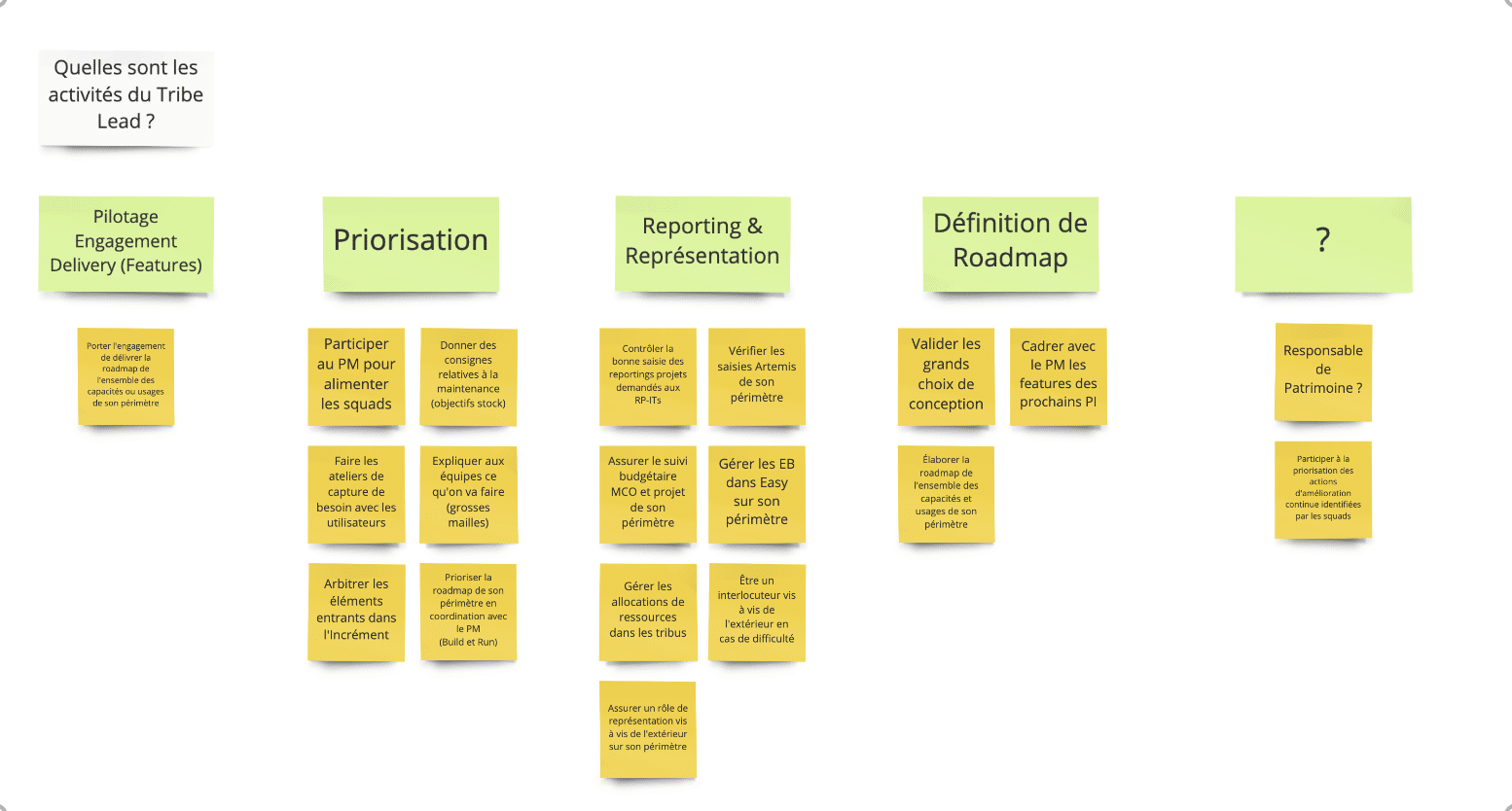
As I reveal the result of the Consensus Workshop – Management to the audience, I invite the Managers to take control to make the comparison. I hope then that this handover in the animation gives a little rhythm to the exchanges.
They initially share around the elements mentioned on both sides, despite a naming that may be a little different. I take the opportunity between 2 exchanges to complete the consolidated vision with these elements, making sure that the terminology used is suitable for everyone.
A debate then broke out at the level of the subjects “that should not be separated”. Indeed, visions differ on these elements and unfortunately not all the people concerned are present to contribute. I then try to shorten the discussion in order to renew it within the framework of a more specific workshop with the right people: something in fact already quite difficult in physics when people exchange in a fairly committed way on a subject, then at a distance, I had to insist on cutting off the discussions. To materialize the fact that these subjects were pending but that they were indeed part of the consolidated vision, I added a “? " next to.
We then obtain the following result:

| Facilitator's Note : at this time, it is important for me to shift the gaze of the participants on the result possibly achievable during the workshop. Indeed, rather than hoping to have a clear, shared and fixed consolidated vision, it seemed more reasonable to me to consider the elements on which they agreed and those which required additional discussion. |
17:05 – Questions / Answers
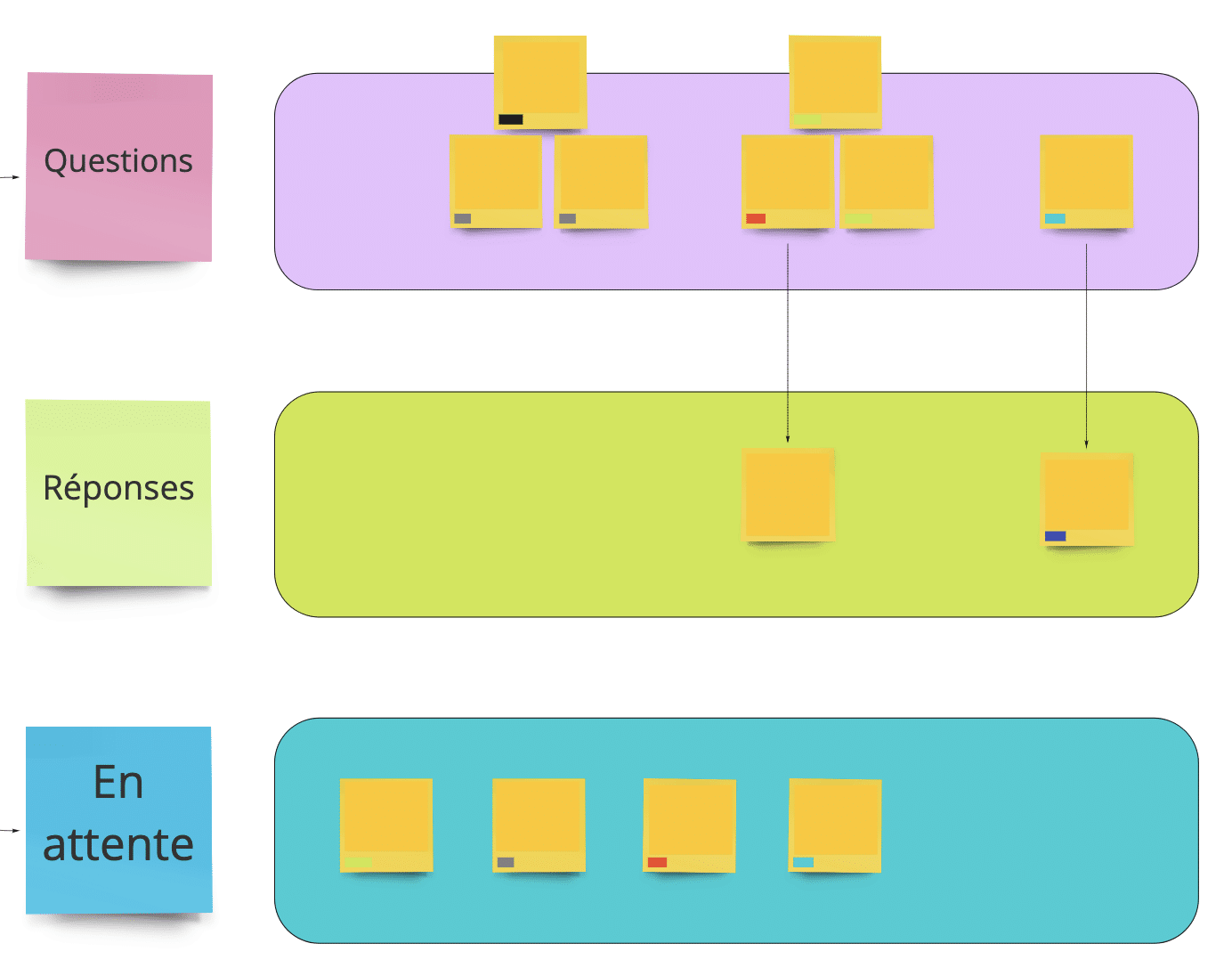
The Q&A sequence was quite fast because most of the questions still pending required to organize a dedicated workshop with potentially other actors. I therefore invited the participants to move on to the last sequence in order to be able to close the workshop with the most limited possible overflow.
| Facilitator's Note : going beyond the timing already seemed like a failure to me as a facilitator. Maybe I'm a little hard on myself, but it was important to me to limit the overflow as much as possible so that the participants did not consider it normal to overflow each time: a habit unfortunately far too present in business. |
5:15 p.m. – Next Steps
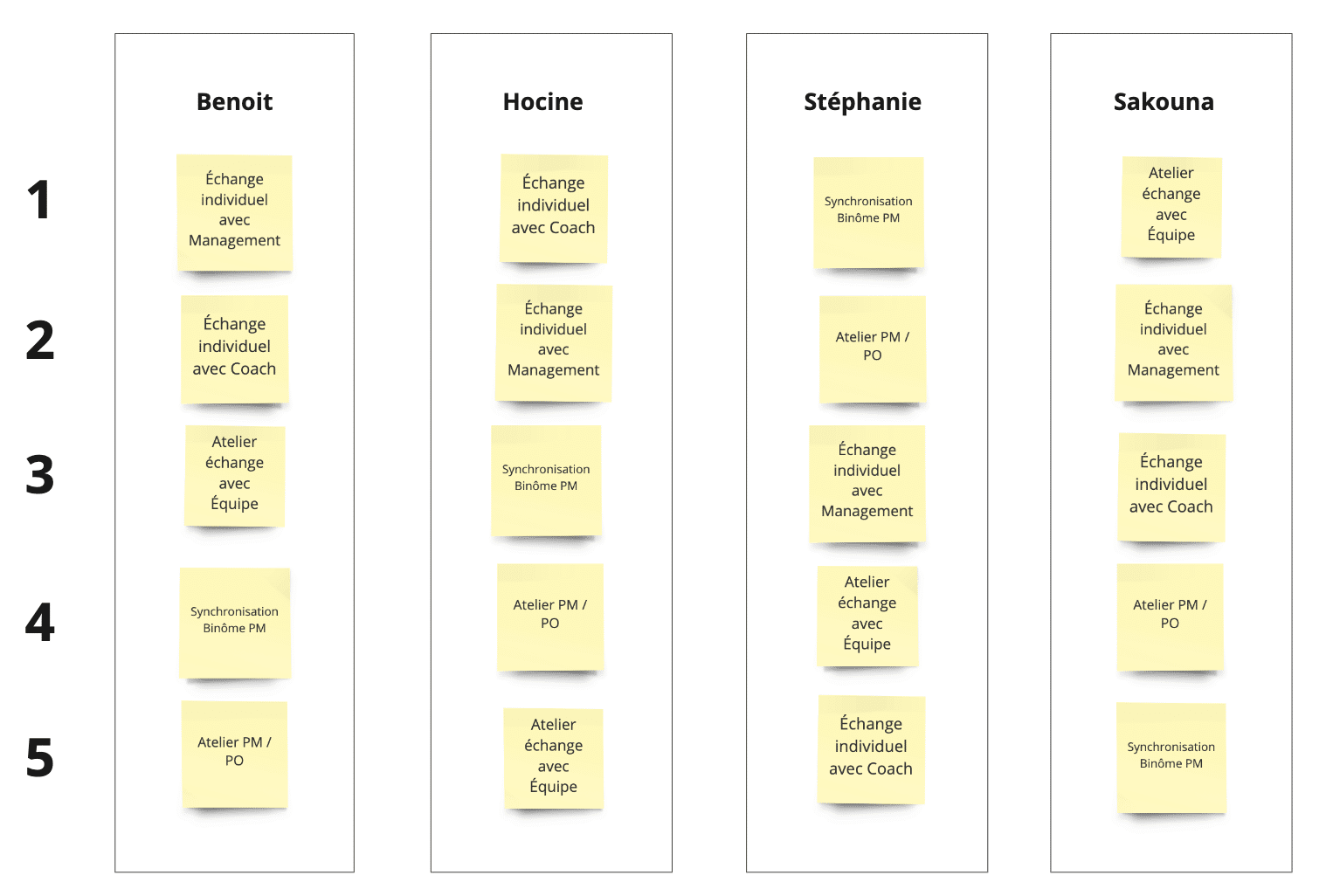
This part is going rather well, we are at the end of the workshop and the instructions are rather simple. I just explain each backlog item before leaving the hand to the participants for their prioritization.
When the movements appear less numerous, I ask for confirmation from each person in order to be able to close the workshop.
17:20 – Conclusion and end of the workshop
Finally, I asked for a few words from the managers on the workshop itself and the results obtained.
Opinions were divided: not that there was any dissatisfaction but rather a feeling of incompleteness. Indeed, the fact of having raised a certain number of questions at the end of the workshop and of not having been able to answer them, either for lack of content or for lack of time, could have been frustrating. This is why we decided that there would be another workshop to deal with the remaining questions or even others that would emerge in the meantime as well as to finalize a shared consolidated vision.
I then had the opportunity to discuss in private to have their feedback: they were generally satisfied even if it was not for the same reasons.
Indeed, they both found the workshop particularly fluid (thanks to my fellow coaches) despite the not very advantageous conditions and above all very different from what they had been able to experience.
One of them shared with me that he was skeptical at first and pleasantly surprised by what we were able to produce. His main frustration is not having been able to debate longer on subjects that were not common. This is why a future workshop on this subject is going to be important!
The other told me that the experience itself was very enriching, both in terms of content and also in terms of setting: it seemed to him surprisingly possible to see the differences in behavior through mouse movements and each during the workshop which was very revealing to him!
Conclusion

This workshop was a great challenge for me, as I am not necessarily used to facilitating entirely from a distance, without having seen the people beforehand: as a facilitator, I work a lot with the non-verbal to adjust not only my posture but also my level of intervention with the participants. Here, it is impossible to do so given the technical constraints and the habits of the participants, unfortunately.
Despite the relatively positive feedback, I personally come away a little mixed and extremely tired. Indeed, given a level of preparation well above normal, I was surprised to have to provide so much energy in this animation. So I can't really understand people who say that switching to full remote hasn't changed anything in their productivity: maybe we don't have the same definition of an "interaction" or maybe that I do not have the necessary skills to date for this to be the case.
This experience was nevertheless rich in learning for me. A very special thank you to my colleagues Alexis Huet and Jacques Labatte for their invaluable help!
Now if I still had some advice to share for the animation of remote workshops:
|
Note: these tips are also applicable for face-to-face animation, they simply seem to me to be all the more important at a distance!
I hope that my testimony has been able to provoke some interesting thoughts in you! If so, do not hesitate to share them with me so that we can exchange, I would be delighted! 🙂







9 Responses
Thank you Olivier for this article. It was Pascale Liroy who recommended that I read it because I am extremely interested in all this.
I think doing this kind of work remotely is exhausting. And stringing together for some of the zooms galore is backbreaking. I have had feedback from managers on this subject. And my own experience tells me the same thing.
Thank you again for this great discovery of tools and the story of your own experience.
Laura
Thank you for your message. I think that it is indeed all the more important today to ask the right questions in our management of meeting times (meetings, workshops, etc.) because our attention and our energy are not solicited in the same way. From my point of view, making it shorter but more often seems to be more appropriate in an age of complexity and uncertainty 🙂
A beautiful day to you!
Olivier
Olivier,
Is Frames a collaborative tool?
THANKS
Laura
Hello Laura,
So I don't know if we are talking about the same thing, but when I mentioned the term "Frames", it corresponded to a functionality present in Miro allowing to structure zones on the whiteboard space and to be able to navigate more easily between these afterwards.
Good for you.
Olivier
Thanks Oliver for sharing.
I will keep your lessons in mind. I have a facilitation to host on Tuesday: retro on a culturally unaccustomed audience, 10 people from different companies… and icing on the cake in English challenge!
Good day to you
Thank you Olivier for this article, always so concrete and detailed. Really very useful!
For the moment, I have led only one remote workshop, energy-intensive indeed, and I will lead some soon. So thank you for your advice!
Please, is there a reason for choosing Miro rather than Mural? (I heard that the handling of Miro is easier, I have not tested yet…).
thanks again !
Florence
Hello Florence,
Thank you for your message ! I'm glad the article was useful to you 🙂
In reality, the choice of Miro was a little bit by chance, it turns out that I rubbed shoulders with people who had already used it (at least under its old name RealTimeBoard) and who gave it to me recommended.
In view of the responsiveness I needed to be able to offer a solution to my client at the start of confinement, I decided to start with a single tool to be able to quickly build my skills on it myself.
I don't think there's really a bad choice, Mural seems to be an equally fun tool to handle from what I've seen. Just get going 🙂
Good luck with your workshops and enjoy!
Olivier
Hello Oliver*
Thank you for this generous sharing. very useful to get started.
can you tell me what the colored stickers correspond to on the post-its?
thanks again
Sandrine
Hello Sandrine,
Sorry for this particularly late return.
If you are talking about the rectangular elements at the bottom of the post-its, these are tags used on Miro. There are mainly the names of the people who put the post-it on it so that it is easier to identify in the animation 🙂
Have a nice evening !
Olivier